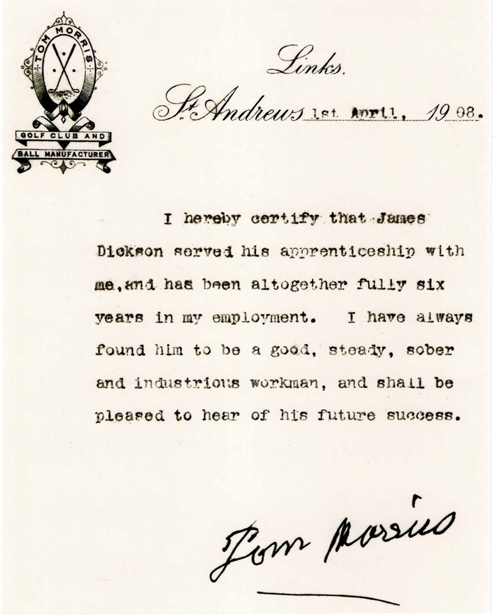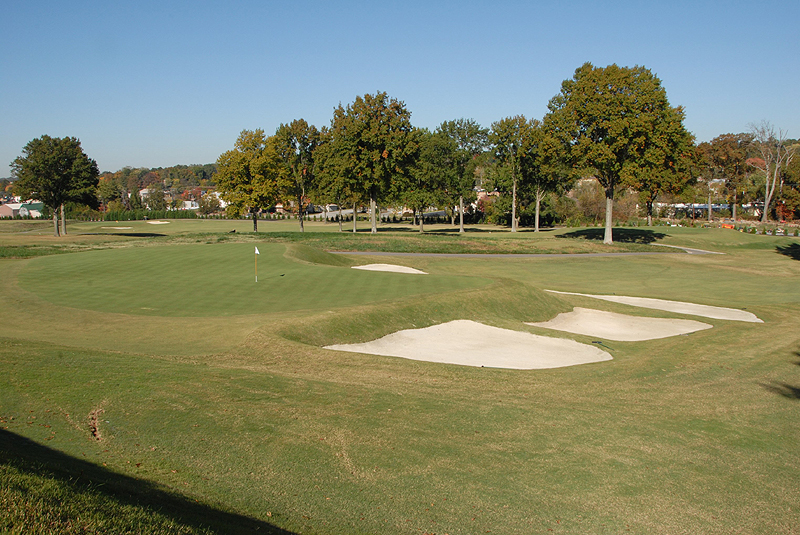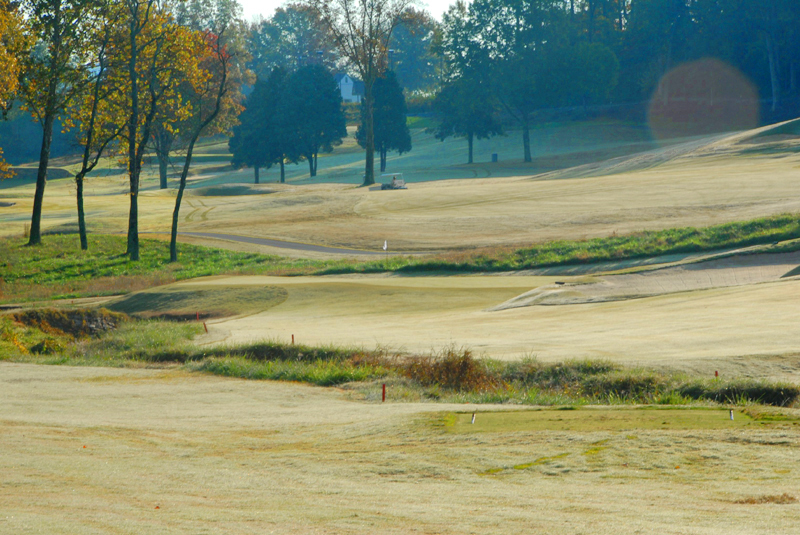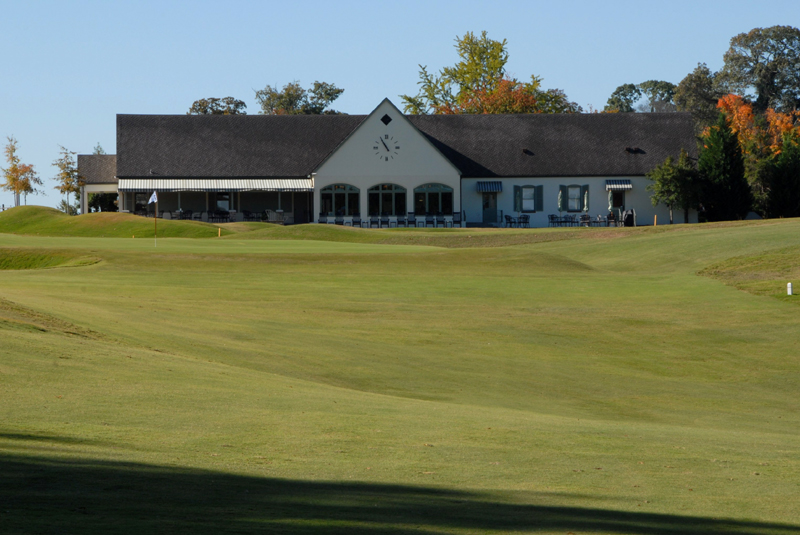Cherokee Country Club, TN, USA
by
Mike Threlkeld & Ken Creed
December, 2010
Superintendent: Jason Sanderson
Cherokee Country Club logo as painted onto the sixteenth fairway for the annual member/guest event.
Cherokee Country Club, in Knoxville, Tennessee is nestled on a bend in the Tennessee River, with sweeping views of the Smoky Mountains. The golf course is a Donald Ross design completely restored by Ron Prichard in 2008.
Founded in 1907, the club started with nine holes. In the summer of 1908, Mr. James (Jimmie) Dickson traveled from Scotland after applying to be the first golf professional at Cherokee. He brought with him a letter of introduction dated April 1, 1908 signed by Old Tom Morris from St. Andrews, Scotland. The date of this letter happens to be just weeks before Old Tom died on May 24, 1908. The letter is hanging in the hall of Cherokee’s golf pro shop along with other golf memorabilia.
Mr. Dickson oversaw the expansion of the course to 18 holes in 1910. Cherokee’s annual Men’s Club Champion is named the winner of the Jimmie Dickson Cup. In 1916, the famous Bobby Jones won the Cherokee Invitational. He was 14 years old.
From the minutes of a meeting of the Board of Directors on July 15, 1919, the Green Committee was “authorized to employ Donald Ross to inspect and suggest improvements to the greens.†On March 3, 1920, “the bill of Mr. Donald Ross amounting to $560.00 for drawing new plans for the golf links†was submitted and ordered paid.
According to the recorded memories of Margaret Dickson, Jimmy Dickson’s daughter, her father and Donald Ross were acquaintances from Scotland through their affiliations with Old Tom Morris. She remembered Ross spending several nights at her family house in Knoxville which was adjacent to hole number two at Cherokee during the period when Cherokee was rebuilt in 1920 and again when cross town neighbor, Holston Hills Country Club was built in 1927.
Over the years, as with many Ross courses, major changes were made. In the 1980’s golf architect Dan Maples was hired, as the Green Committee at that time desired, to modernize Cherokee’s golf course. This “modernization†effort was completed soon after.
In 2000, Mr. Ron Prichard, noted Donald Ross restoration architect, was hired to reconstruct and restore the course back to a Ross design. Unfortunately, the original plans and specifications were lost over time. Mr. Prichard used old aerial course photos along with his extensive knowledge of the design work and philosophy of Donald Ross to develop a master restoration plan which was approved by the membership. Construction on the restoration was started in May, 2008 and the course was reopened for play in December, 2008.
Mr. Ross and subsequently, Mr. Prichard faced unique challenges in routing the golf course because it lies on less than 80 acres that slope from east to west with a meandering creek splitting the property. The west side of the golf course is defined by railroad tracks that are the boundary on four holes. Mr. Ross and Mr. Prichard created a shot-makers golf course with six par three holes, each with demanding play values, four par 5 holes which require accuracy rather than length off the tee, and two challenging par fours each measuring over 460 yards from the back tees. While the Cherokee Country Club course measures less than 6400 yards from the tips, scoring below the par 70 requires excellent short game skills and very good putting techniques on the undulating greens which are planted with bent turf and average less than 5,500 square feet of putting area.
This golf course, which presents most of the strategic challenges of a classic Ross course, has hosted Tennessee State Amateur championships, U.S. Open qualifying rounds, University of Tennessee Women’s SEC and NCAA events, Donald Ross Society outings, and numerous other golfing competitions that attest to its difficulty.
Holes of Note:
Hole Number 4 second shot from 230 yards out.
Hole #4
This par 5 hole is rated the #1 handicap hole. From the back teeing areas this hole measures only 496 yards, but it is a difficult hole because the fairway is narrow with Out of Bounds to the right running from tee to green and a creek crossing the fairway 200 yards from the green and running along the left side of the fairway to the green and beyond. A tee shot with a draw or hook to avoid the out of bounds will likely end up on the saving shelf or in the fairway of hole #5 which then presents a number of difficult options for the second shot. A second shot from the left must avoid several large oak trees and two fairway bunkers just beyond the creek. This forces either a lay up shot short of the creek, or as an alternative, a low hooking shot to avoid the trees and clear the creek hazard crossing the fairway, the two large fairway bunkers on right, and the out of bounds on the right. The creek crossing the fairway is 307 yards from the back tees.
The second shot from the fairway must clear the creek and the two fairway bunkers which are 157 yards from the green. With out of bounds on the right and the creek on the left of the fairway the second shot is a difficult long iron or hybrid shot for most golfers. The green is protected by a bunker on the left that is about 55 yards from the center of the green. Another smaller bunker protects the right side of the green at about 40 yards out.
Further increasing the difficulty of this hole is a green that is quite small, measuring only 31 yards long and 17 yards wide protected by the creek on the left only 6 yards from the green and out of bounds on the right is 7 yards from the edge of the green. A natural grass area planted with fescue protects the rear of the green. The surface area of the green is only 5,432 square feet.
Hole #5
Hole Number 5, par 5 from the tee with Hole Number 7 in the background.
Hole Number 7 Cross Bunkers are 85 yards from Green
Hole #7
This par 4 measures 349 yards from the back teeing area which is elevated 37 feet from the landing area in front of two cross bunkers that pinch the fairway. The forward teeing area is less elevated, but still affords a slightly downhill tee shot from 310 yards. The long hitting player from either set of tees will be tempted and occasionally capable of playing the length of this hole in one shot. The front of the cross bunker on the right is located 90 yards from the center of the green and the front of the left cross bunker is 80 yards from the center of the green.
The rough on both sides of the fairway is sparsely populated with hardwood trees separating the hole from holes #6 and #9. The fairway is relatively narrow before opening slightly at a large tree on the left located about 150 yards from the center of the green. The cart path runs down the right side of the fairway. A very large natural area planted with fescue is about 10 yards to the right of the cart path. The area begins about 200 yards from the back tee and extends forward toward the green.
The green is elevated about 15 feet above the tee shot landing area in front of the cross bunkers. It is one of the smaller greens on the course measuring only 4,875 square feet with a depth of 28 yards and width of 23 yards. The green has a slight 2’ slope back to front with several pronounced undulations on the surface. The green is protected with green side bunkers on the left and right. The rear of the green is closely mown to a saving shelf and slopes sharply down to primary rough. Any approach shot hit through the green will require a recovery shot to be played from 20 feet below the putting surface.
Hole Number 8, a classic Par 3, elevated and protected.
Hole Number 8 showing 4 of the 5 sand bunkers
Hole #8
Ron Prichard, the Golf Restoration Architect said this short par 3, 139 yards from back tees, “is one of the most dramatic short holes I have seen on any Donald Ross golf courseâ€. The putting area is unique, somewhat squared with the sides pulled in between the corners with the left front corner a triangle of surface jutting at an angle towards the tee. The green is rather generous with 5,840 square feet of putting area, but it is defended by five sand bunkers which run across the front and on both sides of the green. The green is significantly elevated above the bunkers which increases the difficulty of playing a ball in one of the hazards onto the putting surface. A stray shot to the right will find the fescue & native grass area which closely borders the cart path.
The back tee is slightly elevated above the forward tees which are placed at 117 yards. Another tee is still farther forward and on the right side of the cart path at 61 yards. From the teeing areas the target appears quite small measuring through the center only 17 yards deep, but 35 yards wide. The green is pitched only slightly to the front. Behind the green is a short drainage swale less than 10 yards in width before the primary rough begins to climb the slope up to the ninth hole teeing area.
Hole Number 11 from the middle teeing area
Hole #11
The eleventh is designated a par 5 even though most long hitters can reach the green in two shots. The length from the back tees is only 474 yards, the shortest par 5 on the course. There are four teeing areas on this hole. A small back tee positioned at 474 yards. A large middle tee at 455 yards and a separate tee created at 435 yards. The most forward tee is set at 386 yards. A natural area of fescue and native grasses surrounds the teeing areas up to the beginning of the fairway 150 yards from the back tees. A stand of hardwood trees and Bermuda rough is off the fairway to the right while left of the fairway the Bermuda rough penalizes the pulled or hooked tee shot. The fairway slopes appreciable from left to right.
A fairway bunker encroaches into the fairway on the left at 225 yards from the back tee. Another fairway bunker is on the right side at 275 yards from the back tee. The positioning of these two bunkers requires a drive either over or beyond the first hazard, or a carefully placed shot short of the hazard. A long pushed shot from the longer hitter will catch the second fairway bunker. On the left side of the fairway, another bunker has been cut into the slope in a position 60 yards short of the putting surface to defend the opening to the green. At the green right front and left greenside are large, deep sand bunkers positioned to catch weak approach shots.
The #11 green is quite large at 6,624 square feet and flows smoothly into the #15 green to form a large and unusual double green. The distance from the front of #11 to the high point separating the two greens is 35 yards with the green area having three distinct levels sloping almost three feet from the high point to a false front at the entry point to the putting surface. The width of the green is 28 yards which is generous considering the short third shot which should be played to the pin location. A shot played through the green presents a difficult uphill recovery shot for the average player with a either a putter from the green surround or a wedge from the rough
Hole Number 12: Note train on track in background! Could be Scotland! The green is shaded by the large tree on the left. The creek runs behind the bunker and beside the tree and the green.
Hole #12
The twelfth hole is a good, long and difficult one shot hole. This par 3 is a tough challenge for players of any skill level. A natural area of fescue and native grasses surrounds the teeing areas up to the creek and the beginning of the fairway. The back tees require a 239 yard shot to reach the center of the green. Middle tee players have 201 yards and the forward tees play from 176 yards. To clear the creek and reach the beginning of the fairway requires a shot carrying 142 yards from the back tees and 105 yards from the middle tees.
The hole is defined on the right by the railroad tracks which run along the boundary of the golf course. The edge of the boundary is planted with a combination of Leyland Cypress, Green Giant Arborvitae, and Japanese Cryptomeria evergreen trees and marked with out of bounds posts. A creek runs along the left edge of the hole as a lateral hazard. A large approach bunker protects the left entrance to the green. The front edge of the bunker is 36 yards from the center of the green and the distance from the back edge of the bunker to the front of the green is about 12 yards. A large contoured mound is at the right front between the green and out of bounds. A drainage swale behind the mound is part of the closely mown surround that borders the green.
The #12 green at 3,760 square feet is quite small to receive the tee shot. A low trajectory shot will likely run through or off of the green into the hazard on the left or the swale on the right. A high shot coming in from the left must negotiate a large sycamore tree that protects the green behind the bunker. The depth of the green is 28 yards, but the width is only 18 yards. The contours of the green are perhaps the most severe of any green on the course with a definite bias and slope from back to front of over 2’.
Hole Number 13 invites play to the right to avoid the creek and the fairway bunker which is shaded by the tree.
Hole #13
This hole demonstrates the Donald Ross philosophy to fit the hole naturally on the available ground. This slight dogleg left par 4 measures 386 yards from the back tees and requires a carefully played tee shot to clear the creek which cuts diagonally across the front edge of the fairway. The carry is shortest to the right, but that leaves a much longer approach shot to the green. A tee shot to the left must be well struck to carry over the creek and clear the first fairway bunker. A tee shot hit too far to the right will find the railroad tracks and go beyond the boundary of the golf course. This hole has six separate teeing areas which allow the positioning of the back tees at 386 yards, middle tees at varying distances (355 to 335 yards), and the forward tees at 251 yards. The fairway slopes right to left the entire length of the hole.
The first fairway bunker on the left edge of the fairway is 170 yards from the center of the green. A second fairway bunker on the left is positioned 100 yards from the green and extends almost to the center of the fairway. The fairway is fairly narrow, measuring only 40 yards across at the target landing area. The rough on the right extends less than 15 yards before the Out of Bounds.
The green is protected by a large bunker on the right corner extended into the opening to the green and deep smaller bunker on the left corner. An approach shot missed to the right of the green will likely hit the cart path and bounce out of bounds. An approach shot left and beyond the bunker will find a closely mown green surround that will funnel the ball down to a deep drainage swale. A shot through the green will find the primary rough and beyond that a tall grass natural area.
The green is fairly deep at 35 yards and slopes noticeable back to front with a 2.5 foot drop. The green is only 23 yards wide. Contours on this green are pronounced so an accurately played second shot is crucial for those expecting to only take two putts. Total square footage of the green is 5,808, an average size.
Hole Number 14: Note creek on left. There is another sand bunker hidden behind the one visible to the right
Hole #14
The last of the six par 3 holes sits tight beside the creek which defines the border between hole #13 and hole #14. There are three teeing areas: Back tees at 171 yards, middle tees at 154 yards, and forward tees at 121 yards. This hole demands a carefully played tee shot to avoid two large bunkers guarding the hole on the right and to avoid the creek left of the green. One of the bunkers is visible from the tee, but the other is hidden. The front edge of the first bunker is about 50 yards from the center of the green. A tee shot of at least 152 yards from the back tees is required to clear the back edge of the first bunker. A tee shot through the green will find a closely mown drainage swale and then immediately a natural area planted with fescue and natural grasses. The distance from the rear of the green to the natural area is less than 15 yards. The slope from the green to the creek is primary rough, but the distance from the edge of the green to the creek is less than 10 yards.
The green is oblong shaped with a prevailing slope from the back left to the right front of about 2’. The green depth is 35 yards and the width through the center is 25 yards. The size of this green is a little over 5,800 square feet which is more generous than hole #12. Contours on this green are tricky to negotiate.
Hole Number 9 from fairway with the Golf House in the background
The restored Cherokee Country Club golf course establishes the intent of Donald Ross (and Ron Prichard) to distinctly challenge every class of player. The major elements of the restoration plan included 1) removal of many trees which had naturally overgrown their space and also remove those planted by well-intentioned Green Committees or Superintendents. Tree removal opens the fairways and promotes healthier turf conditions, 2) restoration of sand bunkers that had been previously eliminated and the addition of sand bunkers Donald Ross likely would have installed for strategic reasons. The golf course has 56 sand bunkers and the Master Plan specifies 11 more to be installed in the future, 3) broaden and realign several fairways to recreate the optional playing positions Donald Ross planned when he laid out a golf course, and 4) re-creation of greens and surrounds which properly reflect the sort of character and challenge sought by Donald Ross. When asked about his golfing experience, a first time guest at Cherokee Country Club will always remember the demand the golf course places on approach shot accuracy and the undulations on the surface of the greens.
~The End~



















